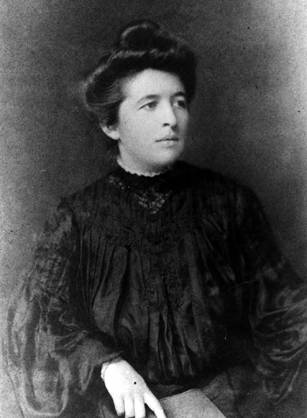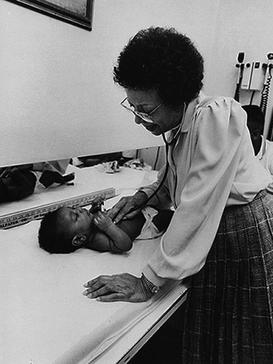
Audrey Forbes Manley is an American pediatrician and public health administrator. Manley was the first African-American woman appointed as chief resident at Cook County Children's Hospital in Chicago (1962). Manley was the first to achieve the rank of Assistant Surgeon General in 1988 and later served as the eighth president of Spelman College.
The University of Cincinnati Academic Health Center (AHC) is a collection of health colleges and institutions of the University of Cincinnati, Cincinnati, Ohio. It trains health care professionals and provides research and patient care. AHC has strong ties to UC Health, which includes the University of Cincinnati Medical Center and West Chester Hospital.

Fe Villanueva del Mundo,, was a Filipina pediatrician. She founded the first pediatric hospital in the Philippines and is known for shaping the modern child healthcare system in the Philippines. Her pioneering work in pediatrics in the Philippines while in active medical practice spanned eight decades. She gained international recognition, including the Ramon Magsaysay Award for Public Service in 1977. In 1980, she was conferred the rank and title of National Scientist of the Philippines, and in 2010, she was conferred the Order of Lakandula. She was the first female president of the Philippine Pediatric Society and the first woman to be named National Scientist of the Philippines in 1980. She was also the founder and the first president of the Philippine Pediatric Society, the first Asian to be elected president of the Philippine Medical Association in its 65-years existence, and the first Asian to be voted president of the Medical Woman's International Association.

Dorothy Mabel Reed Mendenhall was a prominent pediatric physician specializing in cellular pathology. In 1901, she discovered that Hodgkin's disease was not a form of tuberculosis, by noticing the presence of a special cell, the Reed–Sternberg cell which bears her name. Dorothy was one of the first women to graduate from Johns Hopkins School of Medicine. She was also one of the first professionally trained female physicians of the late 19th and early 20th centuries.

Sickle cell disease (SCD) is a group of blood disorders typically inherited. The most common type is known as sickle cell anaemia. It results in an abnormality in the oxygen-carrying protein haemoglobin found in red blood cells. This leads to a rigid, sickle-like shape under certain circumstances. Problems in sickle cell disease typically begin around 5 to 6 months of age. A number of health problems may develop, such as attacks of pain, anemia, swelling in the hands and feet, bacterial infections, and stroke. Long-term pain may develop as people get older. The average life expectancy in the developed world is 40 to 60 years.
Marilyn T. Miller was an American pediatric ophthalmologist specializing in the diagnosis and treatment of congenital eye diseases and strabismus. She held leadership positions in her field.

Susan Shurin is a senior adviser at the National Cancer Institute. From 2006–2014, she served as Deputy and Acting Director of the National Heart, Lung, and Blood Institute (NHLBI) [NHLBI.nih.gov] at the National Institutes of Health [nih.gov] (NIH).

Julie Makani is a Tanzanian medical researcher. From 2014 she is Wellcome Trust Research Fellow and Associate Professor in the Department of Haematology and Blood Transfusion at the Muhimbili University of Health and Allied Sciences (MUHAS). Also a visiting fellow and consultant to the Nuffield Department of Medicine, University of Oxford, she is based in Dar es Salaam, Tanzania. In 2011, she received the Royal Society Pfizer Award for her work with sickle cell disease.

Helen Elizabeth Nash was a pediatrician known for breaking racial and gender barriers in the medical field. She began her career at the Homer G. Phillips Hospital, and later worked at the Saint Louis Children’s Hospital. She started her own private practice and was a faculty member at the Washington University School of Medicine. Her earliest work included decreasing infant mortality in Homer G. Phillips Hospital. Her private practice was notable for educating teens on proper sexual health. Additionally, she was one of the first medical doctors to address patient health as care for the patient and their support systems.
Angella Dorothea Ferguson is an American pediatrician known for her groundbreaking research on sickle cell disease.

Clarice D. Reid is an American pediatrician born in Birmingham, Alabama, who led the National Sickle Cell Disease Program at the U.S. National Heart, Lung, and Blood Institute (NHLBI) at the National Institutes of Health. She went on to become the Director of Division of Blood Diseases and Resources at NHLBI. Reid was a member of the 1985-1986 Taskforce on Black and Minority Health. She has also served as President Emeritus on the American Bridge Association's Education and Charitable Foundation, and has scored a rare perfect bridge score.
Grace Marilyn James was an American pediatrician in Louisville, Kentucky. When she began practicing medicine in 1953, the hospitals in Louisville were racially segregated by law. At the University of Louisville School of Medicine she was the first African-American physician on the faculty. She was also one of the first two African-American women on the faculty at any southern medical school. Additionally, she was first African-American woman to serve as an attending physician at Louisville's Kosair Children's Hospital.
Stuart Holland Orkin is an American physician, stem cell biologist and researcher in pediatric hematology-oncology. He is the David G. Nathan Distinguished Professor of Pediatrics at Harvard Medical School. Orkin's research has focused on the genetic basis of blood disorders. He is a member of the National Academy of Sciences and the Institute of Medicine, and an Investigator of the Howard Hughes Medical Institute.
Terri H. Finkel is an American pediatric rheumatologist and immunologist who is the Children's Foundation of Memphis Endowed Chair and tenured professor of pediatrics at the University of Tennessee Health Science Center and St. Jude Children's Research Hospital. Previously, she was the pediatrician-in-chief, chair of pediatrics and chief scientific officer at Nemours Children's Hospital. She is known for her research into autoimmunity, AIDS, juvenile rheumatoid arthritis, lupus, and cancer. Her work has been recognized in more than 200 publications, 10 U.S. patents, and 4 licensed technologies. Finkel has been placed in the top one percent of American pediatric rheumatologists by U.S. News & World Report. Her numerous honors include being named among America's Top Doctors by Castle Connolly every year since 2011 and induction into the Colorado Women's Hall of Fame in 1996.
Undertreatment of pain is the absence of pain management therapy for a person in pain when treatment is indicated.

Vence L. Bonham Jr., J.D. is the acting Deputy Director of the National Human Genome Research Institute (NHGRI) of the U. S. National Institutes of Health, and is the leader of the NHGRI Health Disparities Unit. His research focuses on social determinants of health, particularly with regard to the social implications of new genomic knowledge and technologies.
Roland Boyd Scott was an American researcher, pediatrician and authority on sickle cell disease. Scott authored a key paper in 1948 describing the incidence of sickle cell in infants that eventually led to the establishment of routine screening for newborns. He established the Howard University Center for Sickle Cell Disease. He was chairman of the pediatrics department at Howard University. He lobbied Congress to pass the Sickle Cell Anemia Control Act of 1971. He authored over 250 academic publications on allergy, growth and development, and sickle cell disease.

Kwaku Ohene-Frempong was a Ghanaian pediatric hematologist-oncologist and an expert in sickle cell disease (SCD). Ohene-Frempong grew up in Ghana and was a standout athlete in track-and-field, later competing for Yale University as well as Ghana at the 1970 British Commonwealth Games. He continued his medical training in the United States, where he completed medical school, pediatrics residency and a pediatric hematology-oncology fellowship. With a professional interest in SCD, Ohene-Frempong was a physician and involved in public health initiatives at Tulane University School of Medicine in New Orleans, Louisiana, and later the Children's Hospital of Philadelphia (CHOP) in Pennsylvania. He continued professional relationships with Komfo Anokye Teaching Hospital in Kumasi, Ghana where he later became a full-time physician after retiring from CHOP. In Ghana, he established public health initiatives for SCD screening in newborns, as well as an SCD clinic for patients with the disease.

Julie Ann Panepinto is an American pediatric hematologist-oncologist and physician-scientist. She specializes in health outcomes research and sickle cell disease. Panepinto became the acting director of the division of blood diseases and resources at the National Heart, Lung, and Blood Institute in 2022. She was a professor of pediatrics and hematology at the Medical College of Wisconsin.

Doris Howell was an American physician who specialized in pediatric oncology. She became known as the "mother of hospice," for her pioneering work in palliative care.











